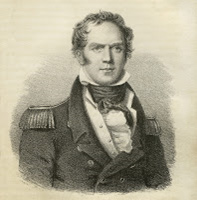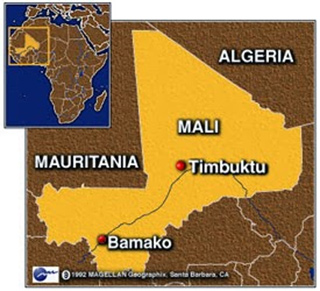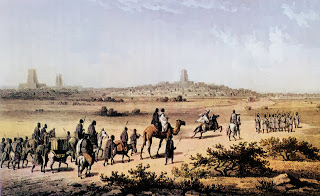El Dorado … Cibola … Quivira … these are all fabled “lost cities of gold” that fired up the imaginations of explorers who pursued their dreams to the four corners of the Earth. These cities only existed in the fevered imaginations of storytellers.
But there was a real city of gold … or at least, a city richly associated with gold. Its discovery by European explorers is the story of unlocking mysterious Africa … a tale that rings down through the ages … and holds lessons for investors today.
The real fabled city of gold is Timbuktu. In present day, this incredibly remote city at the southern edge of the Sahara is not much to look at.
But in 1324, Timbuktu made a dazzling impression on the civilized world when its emperor, Mansa Munsa, passed through Cairo on a pilgrimage to Mecca.
The emperor arrived with a caravan of 60,000 men, all dressed in fine Persian silk and brocade. He was preceded by 500 slaves, each carrying a golden staff weighing four pounds. And Munsa was followed by a baggage train of eighty camels, each weighed down by 300 pounds of gold.
The Golden Emperor …
Munsa made his pilgrimage and passed into history. But he spent so much gold that he flooded Cairo’s market with enough yellow metal to last the next dozen years.
By the late 1700s, when the Europeans started carving up Africa, Timbuktu was lost in the mists of time. Arabs along the Mediterranean coast may have heard of Timbuktu and could even visit it, if they could survive the grueling journey across the Sahara.
But Europeans who tried to reach it were summarily killed by tribesmen who considered non-Muslims “enemies of the prophet” (and juicy targets for robbery and murder).
There was another approach to Timbuktu — through the fever swamps of Africa’s east coast. But these swamps were known as “White Man’s Doom” for a good reason, because the Europeans had no resistance to the diseases that plagued the area.
You might think these would be good reasons to stay away from Timbuktu. But the British and French explorers of 1800, eager for fame and fortune, cast covetous looks at one of the last uncharted places on Earth.
The Last Blank Space on the Map …
By 1800, there remained few corners of the Earth upon which some European foot had not trod. But most of Africa’s map remained blank.
Africa spreads out across 11 million square miles — 3 times the size of the United States, including Alaska. Yet a well-regarded map of Africa produced in 1829 left most of the interior spaces empty. That’s because it was easier to map the surface of the moon with a telescope in 1829 than to produce a detailed map of Africa.
And no destination in Africa burned brighter in the fevered imaginations of Europeans than Timbuktu, a “city paved with gold.”
The Geographical Society of Paris offered a price of 10,000 francs for the first European to travel to Timbuktu and return with proof of his journey. And the race was on.
Many of these expeditions are covered in an excellent book, The Race for Timbuktu by Frank Kryza. I highly recommend putting it on your reading list.
British expeditions were backed by leading figures of the day. But one brave explorer after another would set foot in Africa’s interior only to end up dead in a matter of weeks. The killers were …
Disease. Malaria and other illnesses infested not only the fever swamps but also the oases dotting the desert.
Poor planning. Not only did the explorers have to pack everything they needed for the months-long journey on foul-smelling, spitting camels, but they also had to bring enough money to bribe local warlords. Running out of funds was a common calamity for the British explorers.
Poor navigation. Finding Timbuktu was one problem … finding precious water holes along the way was another. “Whole caravans of a hundred men simply vanished like ships in the ocean because their calculations were off by a hundred yards,” Kryza writes.
Attack. The Arabs, Tuaregs and various tribes of the desert were constantly at war with each other. So traveling in disguise didn’t work that well, because eventually you’d be disguised as someone’s enemy.
Oddballs in the Desert …

Still, lured by tales of Africa’s “city of gold,” the explorers pressed on.
My favorite explorers are a real “odd couple” — Captain Hugh Clapperton, a Scottish-born adventurer, and Lieutenant Dixon Denham, a preening social climber with a mean streak a mile wide.
Clapperton, Denham and their team journeyed across the Sahara and were the first Europeans in recorded history to visit Lake Chad. Along the way, the two men grew to detest each other, and finally resorted to communicating only by writing letters to each other.

Local political intrigue and illness prevented them from pushing on to Timbuktu, so they returned to Tripoli. That was enough for Denham, who was just using the exploration to boost his career.
The Lady or the Crocodile …
But Clapperton became obsessed with finding Timbuktu. And his obsession ignited when he found out that another explorer, Alexander Gordon Laing, was already making a new attempt south from Tripoli. So Clapperton hurried to take his chances through the fever swamps of Africa’s east coast.
Most of Clapperton’s party died of disease in the first 150 miles. Then, exiting the swamps, the survivors entered the country of the Yoruba. There they found a happy, healthy people who were incredibly friendly to the white explorers.

Perhaps too friendly. Clapperton and his surviving team drew the attention of the Widow Zuma, a rich schemer who wanted to marry one of the white men as a way to further her political ambitions. Clapperton might have gone for it.
But the local male ideal of feminine beauty was “the more bulk, the better.” Zuma was the size and shape of a walking water barrel wrapped in fine threads. And she relentlessly wooed the British explorers from one end of the country to the other.
Clapperton and his crew fled Zuma’s attentions, swimming a crocodile-infested river to make their escape.
Finally, though, Clapperton succumbed to disease and joined the rest of his men in the grave. A lone, faithful servant turned back to report the unhappy news.
Success … and Disappointment
Meanwhile, Laing, who was racing Clapperton to find Timbuktu, endured one hair-raising adventure after another and finally reached the fabled city. And what a disappointment!
The city of gold was a city of mud. A thousand years old, it was crumbling. Its population, down from 100,000 at its peak, was reduced to 12,000 and devastated by war. Timbuktu’s golden glory days had long since passed by the time Laing strode through its gates.
Laing was in Timbuktu only a month before he was chased out for being an unbeliever. Then he was murdered and robbed by the men who were supposed to guide him to safety.
Finally, a Frenchman entered Timbuktu and returned to tell the tale.
Rene Caille journeyed from the West Coast of Africa disguised as an Arab, surviving months of illness and hardship. He returned to France to collect his prize from the Geographical Society of Paris and was greeted as a hero. But the fact that Timbuktu was NOT a city of gold was certainly a disappointment to the people following the drama.

Within a short time, the various European powers carved up Africa’s rich interior under the guise of stamping out slavery. And Timbuktu became just another bump on the dusty trail.
What Investors Can Learn from the Men Who Sought Timbuktu …
Persistence Pays Off. Reading the tribulations and exploits of the early explorers, I was constantly reminded that those who persevere can triumph. Refusing to be discouraged by early setbacks was what separated the men from the boys. Even those who didn’t find Timbuktu sometimes found enough to make the journey worth their while.
Be Prepared and Be Flexible. Anything can happen, and often did on the trail from Tripoli to Timbuktu. Whether it was an attack by tribesmen armed with poison arrows or the amorous advances of a truck-sized widow, the best explorers planned ahead, and adapted when plans changed.
Be Open to New Opportunities. Many of the great adventurers had temperaments that drove them to look beyond the next hill. If you never stretch yourself to try new things, you will have missed out on all the thrilling adventures life has to offer. Likewise, while the bear market has burned many investors, those open to new opportunities will likely reap the greatest rewards.
Don’t Let the Sandstorms Throw You Off the Trail. More than once, the explorers lost the trail in the sand-swept Sahara. But they knew the general direction they had to travel, and they pressed on. Today, we need to keep our eyes on the big picture and not let short-term noise throw us off.
Let’s Apply Those Lessons to Gold …
Gold’s eternal value shines through. Much as it beckoned British explorers over vast distances of space and time to Timbuktu, gold now beckons us today.
The explorers of the 1800s arrived in Timbuktu centuries too late to enjoy the city’s golden age. And that leaves us with today’s last lesson: Timing is everything. Don’t be left in the dust when the next upward leg of gold’s journey begins.
All the best,
Sean




